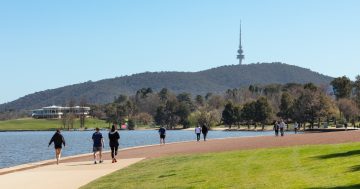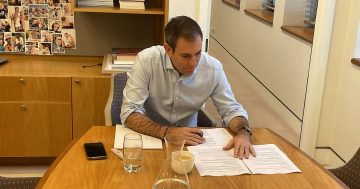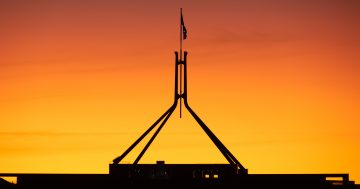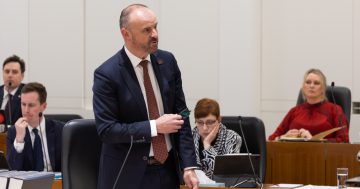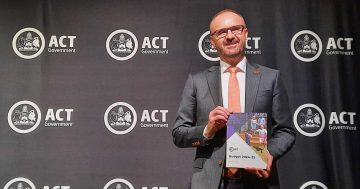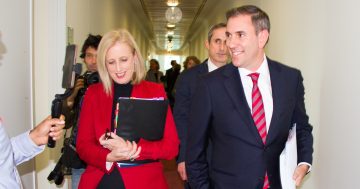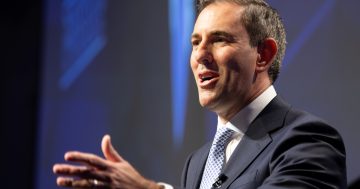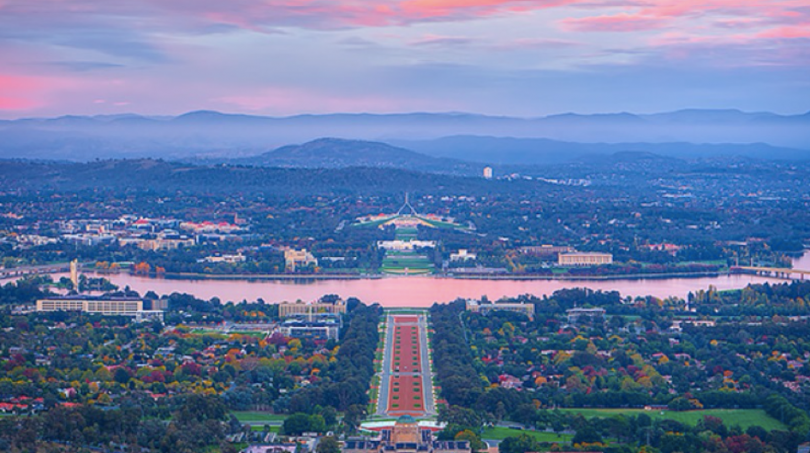
The 2018 Federal Budget didn’t serve up too many surprises. Photo: Supplied by RSM.
A look at the 2018 Federal Budget – Andrew Sykes, RSM Canberra Business Advisory Partner
We are LIVE from Hotel Realm in Barton where Andrew Sykes, RSM Canberra Business Advisory Partner, delivered his summary of the impacts of the 2018 Budget for the Canberra region to over 200 attendees this evening. Keep an eye on the RiotACT in the next day for Andrew's full presentation, and meanwhile, there is more budget-related news here. http://ow.ly/PqRT30jUkWJ
Posted by The RiotACT on Wednesday, May 9, 2018
Last night we learnt what’s in store for the nation when Treasurer Scott Morrison delivered the 2018-2019 Federal Budget, which didn’t serve up too many surprises.
Set to convert our current $18.2 billion deficit into an $11.6 billion surplus by 2020-21, the budget commitments were centred around delivering tax relief, backing businesses to invest and create more jobs, guaranteeing essential services, national security and ensuring the Government lives within its means.
With a coalition Government that’s been consistently lagging behind in the polls since late 2016, we weren’t expecting to see anything too controversial unveiled and anticipated some election ‘sweeteners’ in the form of spending and tax cuts to be thrown into the mix—and that’s exactly what we saw.
Spending
With the unexpected windfall our economy has seen as a result of higher than anticipated revenues, we were forecasting announcements of some big spending on infrastructure projects and increased support for older Australians, so it came as no surprise when the budget delivered on exactly that.
Infrastructure projects proved to be the largest area of investment, with a mammoth $24.5 billion in new spending commitments for road and rail projects as part of the larger $75 billion investment over the next decade.
Victoria was the big winner with a dedicated $7.8 billion for new infrastructure including $5 billion to build a rail link between Melbourne Airport and the city, while we also saw some new national infrastructure initiatives designed to reduce congestion with the $3.5 billion Roads of Strategic Importance package and $1 billion Urban Congestion Fund.
In the ACT, infrastructure spending will include $100 million for the Monaro Highway upgrade to reduce congestion and improve safety, along with $67 million for the Capital Metro under the Asset Recycling Initiative.
As expected, support for older Australians also featured heavily, with $1.6 billion to provide an additional 14,000 home care places to be made available over four years to help the elderly to stay in their homes for longer, an additional $50 per fortnight to go into the pockets of pensioners, and $10,000 wage subsidies for employers who hire workers over the age of 50.
Aged care services in rural, remote and regional Australia will also receive a $146 million helping hand, along with an $82.5 million boost to mental health services in aged care facilities.
The wider health sector will also benefit from the budget with more than $30 billion in additional funding commitments for public hospitals between 2020-21 and 2024-25, guaranteed funding to protect Medicare and the Pharmaceutical Benefits Scheme, and more than $33 million to go to Lifeline Australia to support Australians with a mental illness.
Other significant funding commitments included were:
- the $24.5 billion Quality Schools package to support the findings from the Gonski 2.0 review;
- $2.4 billion investment in public technology infrastructure to boost Australia’s research, science and technology capabilities;
- $1.3 billion to support medical research through the 21st Century Medical Industry Growth Plan;
- initiatives focused around national security including a $294 million package to improve airport security, $122 million to enhance air cargo and international mail screening and $122 million to enhance border force presence at major domestic airports;
- initiatives to target the ‘black economy’, including $160 million to help national police and security officers tackle crime and prevent terrorism, $59 million for the creation of a National Crime Intelligence System and $68 million to establish the Australian Centre to Counter Child Exploitation; and
- various packages to support our farmers, regional tourism and regional communities.
Out of these spending packages, the ACT will receive over $300 million in school funding and $403 million for the Canberra Hospitals, which is ultimately good news but will be spread out until 2024.
Having faced significant criticism surrounding the anticipated level of spending in the lead up to the budget announcement with suggestions that we should instead be considering Australia’s debt levels and focusing on budget repair, the Government seems to have taken the ‘election approach’, delivering a budget designed to appease the majority of voters.
This is clearly a budget aimed at winning an election. The coalition has learnt lessons from horror budgets of the past which squeezed lower and middle income earners. Instead, they have taken a windfall gain of $6 billion in additional revenue as an opportunity to spend their way to victory at the next election.
This is a surprise from a government that was telling middle Australia that paying down national debt was the number one policy. The policy now seems to be to win back the trust of the Australian voter rather than rely on economic rationalist rhetoric. This is a good budget in that it takes a more balanced approach with spending helping to drive growth.
Tax cuts
While we were told not to expect to see significant tax cuts to personal income tax, the budget unveiled a $13.4 billion package to introduce a range of income tax cuts over four years.
In the short term, this will only result in relatively modest reductions to income tax for low to middle income earners, putting an extra $200 to $530 in the pockets of those earning up to $90,000 each year to provide some immediate relief to household budgets.
A medium-term plan to take effect from 2022-23 will introduce a new tax system designed to tackle bracket creep, with the top threshold of the 19 per cent tax bracket increasing from $37,000 to $41,000 and the top threshold of the 32.5 per cent tax bracket further increasing from $87,000 to $90,000.
The 37 per cent tax bracket will then be abolished entirely from 2024, reducing the number of tax brackets to provide a simpler and flatter income tax system which will result in an estimated 94 per cent of tax payers paying a marginal tax rate of 32.5 per cent or less.
They also delivered on their word to fund the National Disability Insurance Scheme (NDIS) through means other than an increase to the Medicare Levy, making a commitment that the scheme was here to stay with the levy to remain unchanged.
These are tax cuts that will impact on low to middle income earners. High income earners have been quarantined from them as the government increasingly takes the policy initiative away from Labor. This has been done by using a rebate system that stops high income earners taking advantage of lower tax rates.
Australian businesses will also benefit from corporate tax cuts designed to encourage growth and investment, the creation of new jobs and higher wages for employees.
Small to medium businesses with an annual turnover up to $50 million will benefit from tax cuts as part of the Ten Year Enterprise Tax Plan, which will also increase the unincorporated tax discount rate, lift the small business entity turnover threshold and extend the access to a range of other tax concessions.
Small businesses will also benefit from the extension of the $20,000 instant asset write-off to encourage them to replace or upgrade assets and reinvest in their business.
We’ll also see a crackdown on multinationals who aren’t paying their fair share of tax through tighter rules on stapled structures, strengthened thin capitalisation rules, and a broadened scope of large multinationals subject to the Multinational Anti-Avoidance Laws (MAAL) and the Diverted Profits Tax (DPT).
What about us?
The ACT can breathe a sigh of relief that we have been largely ignored in the budget. After a series of attacks on the Public Service in previous budgets, it is good to see some growth, with an estimated growth of 900 non-defence jobs. Most of these jobs will be in the ACT as the Home Affairs department continues to expand. There will of course be some job losses, but overall, we will gain.
While the Budget announced a huge infrastructure spend of $25.4 billion, once again, the ACT will miss out on big infrastructure spending. Elections, however, are not won by ACT votes and we only got $100 million each for a Monaro and Barton highway upgrade.
Overall it was a good budget that didn’t do a lot of harm to anyone but a little to help a lot. Clearly, it is designed around the next election with many of the promises. After this, it’s either win or let Labor take the damage from unpicking the middle income earner tax relief.
For a full run-down of Andrew’s take on the 2018 Federal Budget outcomes, tune into the RiotACT Facebook page from 7 pm tonight where Andrew will be interviewed by The RiotACT’s own Ian Campbell, discussing everything from spending to tax cuts.
Andrew Sykes is a partner at RSM in Canberra. All opinions expressed in this article are his own.












